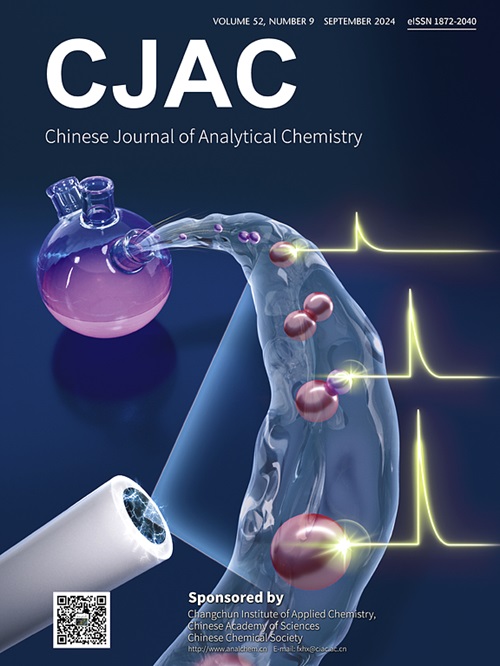Design and performance study of fluorescent molecular probes based on Europium coordination compounds
IF 1.3
4区 化学
Q4 CHEMISTRY, ANALYTICAL
引用次数: 0
Abstract
In this study, the target compound CDA is synthesized through a nucleophilic addition reaction using 2-amino-6-chlorobenzothiazole and ethylenediaminetetraacetic dianhydride as raw materials. The structure of CDA is characterized via ultraviolet-visible (UV–Vis) and fluorescence spectroscopy, revealing its specificity for rare earth metal ions. Concentration titration, interference experiments, and reversibility tests further investigate the relationship between Eu³⁺ and the fluorescence intensity of the probe. The [CDA+Eu3+] system is then applied for antibiotic detection. Results demonstrate that CDA exhibits excellent specificity for Eu3+ in a DMSO/HEPES buffer (pH 7), with a rapid fluorescence enhancement at 617 nm upon Eu3+ addition. This response remains unaffected by other rare earth ions, achieving a detection limit of 0.054 µM. When detecting antibiotics, the [CDA+Eu3+] system specifically recognizes oxytetracycline, chlortetracycline hydrochloride, and tetracycline, inducing fluorescence quenching at 617 nm. Linear relationships are observed for these antibiotics with detection limits of 0.60, 0.48, and 0.59 µM, respectively. Interference experiments confirm that the recognition of tetracycline antibiotics is not compromised by coexisting antibiotics of other classes.

铕配位化合物荧光分子探针的设计与性能研究
本研究以2-氨基-6-氯苯并噻唑和乙二胺四乙酸二酐为原料,通过亲核加成反应合成目标化合物CDA。利用紫外-可见光谱和荧光光谱对CDA的结构进行了表征,揭示了其对稀土金属离子的特异性。浓度滴定、干扰实验和可逆性实验进一步研究了Eu³⁺与探针荧光强度的关系。然后应用[CDA+Eu3+]系统进行抗生素检测。结果表明,CDA在DMSO/HEPES缓冲液(pH 7)中对Eu3+具有良好的特异性,在加入Eu3+后在617 nm处快速荧光增强。该响应不受其他稀土离子的影响,达到0.054µM的检测限。在检测抗生素时,[CDA+Eu3+]系统特异性识别土霉素、盐酸氯四环素和四环素,在617 nm处诱导荧光猝灭。这些抗生素的检出限分别为0.60、0.48和0.59µM,呈线性关系。干扰实验证实,对四环素类抗生素的识别不受其他类抗生素共存的影响。
本文章由计算机程序翻译,如有差异,请以英文原文为准。
求助全文
约1分钟内获得全文
求助全文
来源期刊
CiteScore
3.60
自引率
25.00%
发文量
17223
审稿时长
35 days
期刊介绍:
Chinese Journal of Analytical Chemistry(CJAC) is an academic journal of analytical chemistry established in 1972 and sponsored by the Chinese Chemical Society and Changchun Institute of Applied Chemistry, Chinese Academy of Sciences. Its objectives are to report the original scientific research achievements and review the recent development of analytical chemistry in all areas. The journal sets up 5 columns including Research Papers, Research Notes, Experimental Technique and Instrument, Review and Progress and Summary Accounts. The journal published monthly in Chinese language. A detailed abstract, keywords and the titles of figures and tables are provided in English, except column of Summary Accounts. Prof. Wang Erkang, an outstanding analytical chemist, academician of Chinese Academy of Sciences & Third World Academy of Sciences, holds the post of the Editor-in-chief.

 求助内容:
求助内容: 应助结果提醒方式:
应助结果提醒方式:


